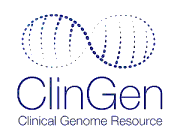The ClinGen Evidence Repository is an FDA-recognized human genetic variant database containing expert-curated assertions regarding variants' pathogenicity and supporting evidence summaries.
[Disclaimer]
- Despite there being a valid 'cspec' property in the messages there's a discrepancy in message contents and CSPEC data: * Message Gene: MT-ND1 CSPEC Genes: [] * Message MONDOs: MONDO:0044970 CSPEC MONDO: []
- No CSPEC computed assertion could be determined for this classification!
Variant: NC_012920.1:m.3481G>A
- Curation Version - 1.1
- Curation History
- JSON LD for Version 1.1
CA345910
155880 (ClinVar)
Gene: MT-ND1
Condition: mitochondrial disease
Inheritance Mode: Mitochondrial inheritance
UUID: 178d8221-14f2-4727-829b-3c3f5d1a3ebd
Approved on: 2023-09-26
Published on: 2024-11-25
HGVS expressions
NC_012920.1:m.3481G>A
J01415.2:m.3481G>A
ENST00000361390.2:c.175G>A
Evidence submitted by expert panel
The information on this website is not intended for direct diagnostic use or medical decision-making without review by a genetics professional. Individuals should not change their health behavior solely on the basis of information contained on this website. If you have questions about the information contained on this website, please see a health care professional.
